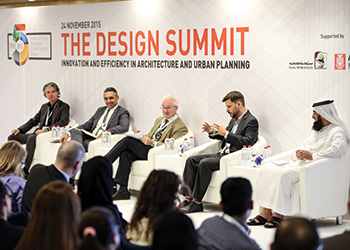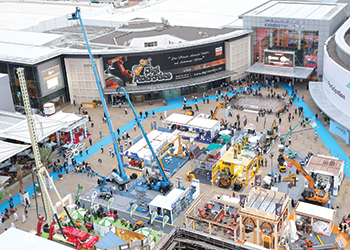Show gets new look
01 October 2016
The Big 5 2016 has been tuned to market demands; an entirely new floor plan allows visitors to easily access products of their choice, while for the first time they will be voting for the Gaia awards.
The 2016 edition of The Big 5 is expected to attract 75,000 visitors and over 3,000 exhibitors across the entire Dubai World Trade Centre (DWTC) venue when it opens in Dubai, UAE, next month.
This year’s mega event – which will be held from November 21 to 24 – has an entirely new floor plan, where exhibitors have been grouped into five product sectors, making it easy for visitors to find the products or companies they are looking for, according to the organiser.
The Big 5 continues to be the number one choice for construction professionals across the industry and the reason is simple; it’s the single largest source of thousands of local and international products under one roof in addition to the latest innovations and trends, according to dmg events, the organiser.
“No other show offers the opportunity to meet and network with so many key decision makers and industry professionals, sourcing thousands of products from international and local manufacturers,” says Josine Heijmans, event director of The Big 5.
Also held in conjunction with The Big 5 will be the PMV Live and Middle East Concrete exhibitions.
Alongside the exhibition, The Big 5 2016 will offer 75 free-to-attend and CPD (continuing professional development)-certified workshops, 30 live demonstrations, and a one-day Excellence in Construction Summit gathering industry leaders to discuss latest technologies, innovations and best practices in construction.
 |
The Big 5 2016 will offer 75 free-to-attend and CPD-certified workshops. |
The mammoth show also speaks volumes on Dubai’s construction industry, which has seen an upsurge in projects. According to BNC’s “Dubai Construction Market 2016” report commissioned by The Big 5, more than 3,700 projects worth a total of around $400 billion are currently ongoing across the emirate.
Dubai’s construction market is on an upward trajectory, the report shows. Although approximately 21 per cent of the projects are on hold, a large number of them are in advanced stages of construction, with an estimated value of over $100 billion.
According to the BNC project intelligence database, commercial and residential units, education, healthcare and hospitality buildings, leisure and recreation facilities, religious buildings, retail facilities and mixed-use urban developments make up approximately 77 per cent of all project values in Dubai, amounting to almost $320 billion.
“A growing population, the tourism sector, strategic government investments like the Dubai Plan 2021 and the Dubai Expo 2020 are fuelling the local construction industry,” says Heijmans.
Dubai’s population is expected to reach 3.4 million in 2020 from 2.46 million today. The emirate is also becoming a major destination hub for international travellers. Last year, it welcomed 14.2 million overnight visitors, and is on track to reach 20 million by 2020.
“This impressive increase is likely to put a strain on the city’s infrastructure, creating a need to expand its capacity,” she says.
Indeed, state planning is strongly supporting the construction market’s growth. The government has outlined an ambitious 2021 Plan, which includes the development of Dubai as a “Smart and Sustainable city”.
The emirate is also getting ready to welcome up to 25 million visitors to the first World Expo in the Middle East, 70 per cent of whom are expected to come from overseas. The total spend on infrastructure projects related to Dubai Expo 2020 might reach up to $18 billion, with estimated development costs of the Dubai South area between $8.1 billion and $8.7 billion, according to dmg events.
 |
|
Live demonstrations are part of The Big 5. |
New floor plan
Commenting on the new floor plan of the show, Heijmans says she is confident the new layout will facilitate business opportunities, while effectively responding to the current needs of construction industry professionals.
“One of the key reasons for our visitors to attend The Big 5 is to look for specific products, innovations and new technologies as well as to network with new or existing business partners and industry peers,” she says.
Although the event’s old layout already accommodated dedicated product sectors, the majority of the international exhibitors were located in country pavilions. This, coupled with the expansion of The Big 5 over the years, made it more challenging for attendees to find the specific products or the companies they were looking for.
The new floor plan is the result of a meticulous analysis of the industry’s current needs. The five product sectors in which exhibitors will be grouped this year are: Building Interiors and Finishes; MEP (mechanical, electrical and plumbing) Services; Building Envelope and Special Construction; Construction Tools and Building Materials; and Smart Building and Design technologies.
“These main sectors are further broken down into subsectors, so it will be really easy to navigate the exhibition halls and find the right exhibitors and products. In addition, a new app, route planners, a search function on the website and staff onsite will further support visitors attending the show,” adds Heijmans.
Beyond offering both visitors and exhibitors a better experience, the new floor plan is aligned with the construction industry’s current trends, as the introduction of the Smart Building and Design Technologies sector shows, she adds.
Heijmans also promises a stronger focus on sustainability at The Big 5 this year.
GAIA Awards
Since 2008, the Gaia Awards at The Big 5 have been honouring the products and services that help reduce the construction sector’s impact on the environment in the Middle East.
Ahmad Bukhash, director of Urban Planning of the Dubai Creative Clusters Authority (DCCA) and member of the Gaia Awards judging panel, comments: “Last year’s winner is an excellent example of how the Gaia Awards promote sustainable products available in the market and support companies that are truly revolutionising the industry.”
In 2015, Gaia Awards winner Basalt Rock Composite presented the basalt composite rebar, an innovative product that replaces steel bars with basalt in concrete reinforcing. “The diffusion of the basalt composite rebar will have a tremendous impact on Dubai’s construction industry, where concrete steel was used extensively in almost all projects,” Bukhash adds.
Open to organisations whose products are distributed within the Middle East and North Africa (Mena) region, the eighth edition of Gaia Awards will take place at the DWTC on November 23. A panel of industry experts with acclaimed credentials will select the overall winner and the winners for the five product sectors.
This year for the first time ever, shortlisted products will be voted for by the public through a voting page on The Big 5 2016 website. Voting stations will also be available at the venue during the first and second days of the event. The Gaia Awards’ judging panel will include these votes in their decision while selecting the final winner of 2016.
The Gaia Awards’ entry criteria focus on three factors: people, planet, and profit.
Dr Alaa Ashmawy, professor of civil engineering, dean of the School of Engineering at the American University in Dubai, and chairman of the Gaia Awards judging panel, explains: “The “people” component deals with how the product contributes to human welfare, comfort, and health. The “planet” aspect addresses the impact of the product on the planet, in terms of reducing greenhouse gases and reducing, reusing, and recycling material. The “profit” component ensures that the product is suitable for implementation in the Mena region and is economically sustainable.”
Mario Seneviratne, managing director of Dubai-based engineering consultancy company Green Technologies and member of the Gaia Awards judging panel, says: “The Gaia Awards are an excellent platform to identify truly sustainable products in the Middle East.”
The UAE was named one of the top 10 markets for green building space by the US Green Building Council (USGBC) in 2015 with the eighth-largest stock of Leed (Leadership in Energy and Environmental Design)-certified buildings outside the US. Dubai was also ranked eighth in a list of top 10 global cities for green buildings by consultancy firm Solidiance.
According to statistics released by Green Technologies, a supporting partner of the Gaia Awards, as of August 2016, the UAE has 221 USGBC Leed-certified buildings, followed by Saudi Arabia (124) and Qatar (97).
The Big 5 2015
Last year, the show recorded an 11 per cent growth over 2104. There were 3,104 exhibiting companies from 67 exhibiting countries covering 113,526 sq m of exhibition space. A total of 73,584 visitors came to the show, making it the biggest Big 5 show to date. Some 46,866 of these were from the GCC and 26,718 from the rest of the world.



